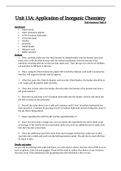Essay
Unit 13A - : Investigate acid-base equilibria in order to understand buffer action and to optimise acid-base titration procedures
- Course
- Institution
This is my Unit 13A assignment. I spent lots of time and effort on this and have achieved a DISTNICTION from this. If you have any questions, enquires or need some assistance please feel free to send me a message. Good luck with your assignment! If you could also just leave me a review that would h...
[Show more]



